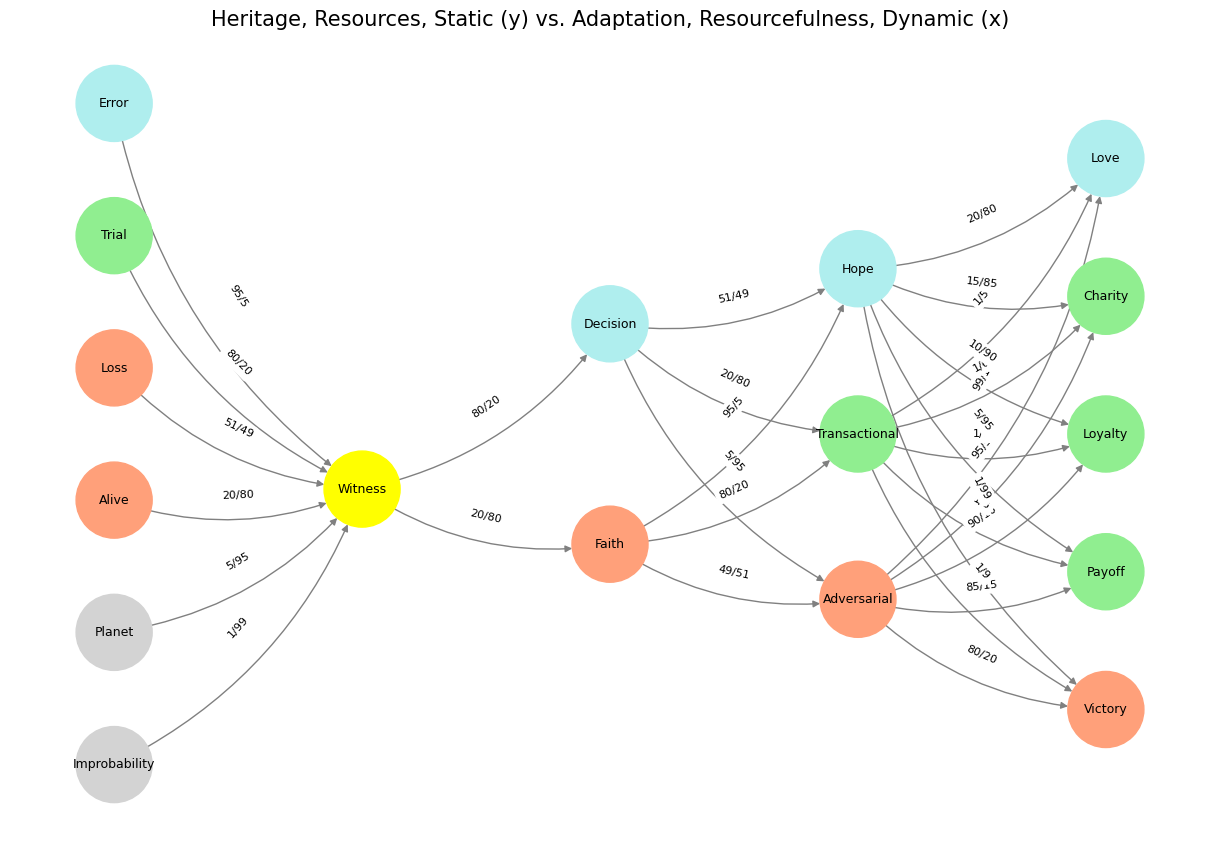Duality#
The tree stands as a paradox of time—ancient, yet ceaselessly renewed. Its roots seem motionless, unchanging, gripping the soil with an authority that feels eternal. But this stillness is an illusion. The earth shifts beneath it, unseen processes of erosion and nutrient cycles altering the foundation it depends on. What appears static is merely dynamic at a scale too vast for the human eye to register. Ukubona—the world looks still, but only because we are too small, too brief, to witness its slow movement.
If we take the y-axis as resources and the x-axis as resourcefulness, then the tree itself becomes an expression of balance across time and adaptation. Its roots—Suis—draw from deep reservoirs of probability and improbability, trial and error, the unseen negotiations with the soil that determine whether life can continue. The nutrients it absorbs are not limitless. If the ground beneath it grows barren, the tree’s deep foundations will not save it. Its roots, once a source of strength, become an anchor to death. The earth itself is dynamic, and a tree that does not recognize this risks extinction.

Fig. 14 Trump vs. Jules. The juxtaposition of Donald Trump and Jules Winnfield from “Pulp Fiction” is as perplexing as it is intriguing. Jules, portrayed by Samuel L. Jackson, is a philosophical hitman who undergoes a profound transformation after a near-death experience, leading him to question his violent lifestyle and seek redemption. In contrast, Trump, a figure entrenched in the worlds of business and politics, often exhibits a brash and unyielding demeanor, seemingly impervious to introspection or change.#
Higher up, in the trunk—Voir, the witness—there is a stability that is deceptive. The trunk does not move in the way that leaves do, but it is not immutable. It bears scars of past wounds, thickens with time, adjusts in small ways to the pressures of wind and weight. Here, the tree does not yet act; it merely endures, recording the past in the rings of its body. It is the site of knowledge but not yet of choice.
When the tree divides into its great branches—Choisis, the realm of decision—it begins the work of strategy. The branches must reach outward toward light, but not recklessly. Some grow too quickly and snap in storms; others hesitate and are starved of the sun. The choice between Faith and Decision is the pivot between waiting and action, between trust in what cannot be seen and the necessity of movement.
At the finer branches—Deviens—the stakes become more immediate. Here, the world is contested. The tree competes against wind, insects, disease. Its strategies shift; some branches grow aggressively, while others remain cautious. These are the realms of Adversarial, Transactional, and Hope. In this space, there is no certainty, only probability. What works in one season may fail in another. The tree must be resourceful, shifting its energy to what is most vital.
Finally, at the outermost layer, where resourcefulness meets its most delicate form, the leaves emerge. M’élève, the emergent truth of all that has come before. These are the fleeting expressions of victory, payoff, loyalty, charity, love. They are beautiful, but their survival is precarious. A late frost, a drought, and they are gone. Yet, without them, the entire system collapses. The tree breathes through them, draws energy through them. They are the final testament that life, even in its most fragile forms, is essential.
This is where the Bible enters, not as a book of static truths but as a text that pulses with life across different scales of time. The essential truths of God are not rigid laws but deep-rooted foundations—unchanging not because they are motionless, but because they move on a time scale beyond human perception. The static truths of the Bible are like the roots of the tree, unseen but holding everything in place. They do not shift with every passing season, but they are not immune to the erosion of neglect. If a society abandons these deep truths, the ground itself changes beneath them, and what once stood firm begins to crumble.
The stories of the Bible, by contrast, are dynamic. They play out across the branches and leaves, in the realm of decision, adversity, transaction, and hope. These stories change with context, with perspective, with time. David’s triumph over Goliath, the suffering of Job, the exile and return of Israel—these are not static events but ongoing realities, eternally relevant in different forms. They are the leaves of the great tree of divine truth, emerging fresh in each generation, shaped by the conditions of their time but always drawing from the same deep root.
Even the Promised Land itself is dynamic. The land given to Israel is not an eternal guarantee but a living relationship. When the people follow God, the land flourishes; when they stray, it withers. It is not the land that is holy in itself but the alignment between divine truth and human faithfulness. The earth, like the tree, can become barren. A place that once supported life may no longer be the right ground. The migration of Abraham, the exile to Babylon, the flight into Egypt—these are not betrayals of the land but acknowledgments that even stability must sometimes be left behind.
The Bible, then, is not a contradiction between static truth and dynamic story. It is a compression of time scales. What we call “static” is simply dynamic across an incomprehensible scale. What we call “dynamic” is merely the flickering leaves on the edges of a vast, ancient structure. The tree lives because it moves within both, because it balances resource and resourcefulness, because it understands when to remain and when to reach outward.
The greatest mistake would be to believe that the tree is immortal. If the ground beneath it fails, if the conditions that sustain it vanish, no amount of history will preserve it. It may need to be planted elsewhere. And yet, wherever it grows, its roots will always reach for the same deep truths, and its leaves will always emerge in their season, new but never unfamiliar, fragile but never meaningless.
Show code cell source
import numpy as np
import matplotlib.pyplot as plt
import networkx as nx
# Define the neural network layers
def define_layers():
return {
'Suis': ['Improbability', 'Planet', 'Alive', 'Loss', "Trial", 'Error'], # Static
'Voir': ['Witness'],
'Choisis': ['Faith', 'Decision'],
'Deviens': ['Adversarial', 'Transactional', 'Hope'],
"M'èléve": ['Victory', 'Payoff', 'Loyalty', 'Charity', 'Love']
}
# Assign colors to nodes
def assign_colors():
color_map = {
'yellow': ['Witness'],
'paleturquoise': ['Error', 'Decision', 'Hope', 'Love'],
'lightgreen': ["Trial", 'Transactional', 'Payoff', 'Charity', 'Loyalty'],
'lightsalmon': ['Alive', 'Loss', 'Faith', 'Adversarial', 'Victory'],
}
return {node: color for color, nodes in color_map.items() for node in nodes}
# Define edge weights (hardcoded for editing)
def define_edges():
return {
('Improbability', 'Witness'): '1/99',
('Planet', 'Witness'): '5/95',
('Alive', 'Witness'): '20/80',
('Loss', 'Witness'): '51/49',
("Trial", 'Witness'): '80/20',
('Error', 'Witness'): '95/5',
('Witness', 'Faith'): '20/80',
('Witness', 'Decision'): '80/20',
('Faith', 'Adversarial'): '49/51',
('Faith', 'Transactional'): '80/20',
('Faith', 'Hope'): '95/5',
('Decision', 'Adversarial'): '5/95',
('Decision', 'Transactional'): '20/80',
('Decision', 'Hope'): '51/49',
('Adversarial', 'Victory'): '80/20',
('Adversarial', 'Payoff'): '85/15',
('Adversarial', 'Loyalty'): '90/10',
('Adversarial', 'Charity'): '95/5',
('Adversarial', 'Love'): '99/1',
('Transactional', 'Victory'): '1/9',
('Transactional', 'Payoff'): '1/8',
('Transactional', 'Loyalty'): '1/7',
('Transactional', 'Charity'): '1/6',
('Transactional', 'Love'): '1/5',
('Hope', 'Victory'): '1/99',
('Hope', 'Payoff'): '5/95',
('Hope', 'Loyalty'): '10/90',
('Hope', 'Charity'): '15/85',
('Hope', 'Love'): '20/80'
}
# Calculate positions for nodes
def calculate_positions(layer, x_offset):
y_positions = np.linspace(-len(layer) / 2, len(layer) / 2, len(layer))
return [(x_offset, y) for y in y_positions]
# Create and visualize the neural network graph
def visualize_nn():
layers = define_layers()
colors = assign_colors()
edges = define_edges()
G = nx.DiGraph()
pos = {}
node_colors = []
# Add nodes and assign positions
for i, (layer_name, nodes) in enumerate(layers.items()):
positions = calculate_positions(nodes, x_offset=i * 2)
for node, position in zip(nodes, positions):
G.add_node(node, layer=layer_name)
pos[node] = position
node_colors.append(colors.get(node, 'lightgray'))
# Add edges with weights
for (source, target), weight in edges.items():
if source in G.nodes and target in G.nodes:
G.add_edge(source, target, weight=weight)
# Draw the graph
plt.figure(figsize=(12, 8))
edges_labels = {(u, v): d["weight"] for u, v, d in G.edges(data=True)}
nx.draw(
G, pos, with_labels=True, node_color=node_colors, edge_color='gray',
node_size=3000, font_size=9, connectionstyle="arc3,rad=0.2"
)
nx.draw_networkx_edge_labels(G, pos, edge_labels=edges_labels, font_size=8)
plt.title("Heritage, Resources, Static (y) vs. Adaptation, Resourcefulness, Dynamic (x)", fontsize=15)
plt.show()
# Run the visualization
visualize_nn()

Fig. 15 Tryptophan, Tryptamine, and Y’all Who Be Trippin’. Information in nature is encoded in gravity and photons and zapped from the cosmos, to earth, to life, to silicon. As for the point of view, thats open for discourse. Source: Lorenzo Expeditions. And if we invert all the aforementioned, then we might say something like: The code provides a unique blend of art and science, creating a visual narrative that might engage viewers in thinking about the structure of thought, decision-making, or the whimsical nature of reality as depicted in “Alice’s Adventures in Wonderland” - Grok-2.#

